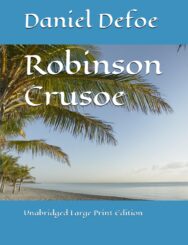 Robinson Crusoe
Robinson Crusoe
Unabridged Large Print Edition
by Daniel Defoe
Not a machine-scanned reproduction of an old version, this quality large print volume is printed on heavyweight bright white paper with a fully laminated cover. Prepared by human editors, It includes the complete text of Daniel Defoe’s classic tale in a freshly formatted edition, along with a detailed biography discussing the incredible real life of the author and an introductory essay, intended for modern readers and not literature classrooms, discussing the literary significance of this work.
Published in 1719, “Robinson Crusoe,” is one of the most widely read, frequently reprinted and widely translated books in the English language. Often recognized as the first modern novel, the book was an immediate success and introduced the realism movement in English literature, as well as originating the still-popular “castaway” genre.
The storyline familiar to most readers, with Robinson Crusoe shipwrecked and stranded on a deserted island, actually takes place on Crusoe’s third sea voyage, the first having ended in shipwreck and the second with his being captured by pirates. Despite these misadventures Crusoe returns to sea, only to be shipwrecked again. This time he alone survives, and over the ensuing twenty-eight years the resourceful and increasingly self-reliant castaway manages not only to survive but to become relatively comfortable under the circumstances. When cannibals from a nearby island visit “his” island to kill and eat their captives Crusoe aids one of the captives who escapes and becomes Crusoe’s faithful servant and companion, “Friday”.
Although many have read “Robinson Crusoe” simply as a compelling and original tale of adventure, complex themes and interpretations are not hard to find. Crusoe’s deliberation over killing the cannibals raises the issue of cultural relativism. The novel has been interpreted in terms of European colonialism, Christian redemption, and even economics, with the classical school of thought using the tale to illustrate the allocation of labor to the value of production. Karl Marx ridiculed economists for using a work of fiction as a model, and then used it himself to support his argument that labor is inherently more valuable than capital.
Certainly all of these themes can be found in the pages of this timeless classic, but perhaps the reason for its enduring popularity, aside from the simple narrative style, interesting characters and creative storyline lies, in part, in the fact that it is, after all, a compelling and original tale of adventure.
Most likely born sometime between 1659 and 1661, Daniel Foe began calling himself Defoe sometime by the late 1690’s and became a merchant, trader, writer, tax collector and spy. In addition to notable works of fiction and pioneering efforts as a novelist, Defoe was an early economic journalist, a successful poet, a fiercely combative political pamphleteer, a widely read author of Christian “guide to proper living” books and an early writer on psychology and the supernatural.
Nearing sixty years of age, Defoe’s greatest works as a writer commenced with Robinson Crusoe in 1719. In the following decade he would publish over a half-dozen novels, including Moll Flanders (1722), as well as his well-received “guide” books, non-fiction works on the deterioration of British society, the supernatural, foreign trade and travel, and most remarkably, the three-volume “Tour Through the Whole Island of Great Britain” (1724-1727), a monumental work depicting in detail the state of economics and trade in an England at the brink of the industrial revolution.
Product details
Publisher: Apex Publications, Independently published (March 2, 2024)
Language: English
Paperback: 379 pages
ISBN: 979-8883227478
Item Weight: 1.86 pounds
Dimensions: 7.44 x 0.86 x 9.69 inches

